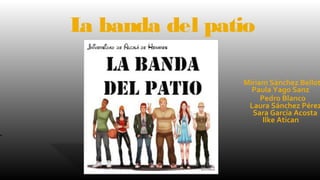La banda de patio 3 b
- 1. La banda del patio Miriam SÃĄnchez Bellot Paula Yago Sanz Pedro Blanco Laura SÃĄnchez PÃĐrez Sara GarcÃa Acosta Ilke Atican
- 2. ïĄGroup organization (commitment, objectives and micro-task) ïĄGuide of cooperative learning: ïŪGroup distribution. ïŪClass organization. ïŪEquipment plan. ïŪInternal organization. ïŪEvaluation in a cooperative learning. ïŪTechniques about cooperative learning.
- 3. PERSONAL TASK PERSON IN CHARGE Speaking more Miriam and Laura Speaking in English Pedro Speaking in English quickly Sara Organize myself Paula Understand more Spanish Ilke
- 4. OBJECTIVES PEOPLE IN CHARGE Speaking in English Ilke Organization Paula and Laura Informatic learning Pedro Learning about cooperative learning Miriam Make a cooperative group Sara
- 5. MICRO-TASK PEOPLE IN CHARGE Read the article All Search the main ideas All Answer the questions All Take notes Pedro and Miriam Make the power point Sara Organice the power point Laura Review and upload Paula and Ilke
- 6. All the classes have diversity so we have to make activities for these differences. The cooperative learning consists on helping each other despite the students level. They learn to share information, knowledge , and abilities.
- 7. ïĄ Base group. (heterogeneous) is stable and it lasts for all the course. The teacher makes the organization of dividing the class in three columns of people based on the interests and motivations of the students. ïĄ Sporadic group. The students have to prepare one topic and show it to their classmates. ïĄ Expert group. (heterogeneous) lasts less time, the objective of this group is to help each other to improve their learning. In each group there are people with the same level.
- 8. Base teams.
- 10. ïĄ Make easier the dialogue. ïĄ The teacher is not the centre of attention. ïĄ The teacher could see all the groups. ïĄ The teacher could see all the groups and help then better.
- 11. ïĄPutting the name of all members , objectives and the assessment. ïĄReflection about cooperative team and we improve the objectives. ïĄEvaluation: We evaluate sessions each day , both in groups as individually.
- 12. ïĄTake account members of the group and their roles. ïĄEveryone has to have commitments , they are going to change through time. ïĄReview of the tasks days later and add or change the commitments. ïĄAll the members have to demand the group work to get a good mark. ïĄEach one has to make their work like habits , with consciousness.
- 13. ïĄThe final evaluation will consist of to see if the students have carried out the objectives of the group and wether or not each student have worked more than other. ïĄThe note will be different depending on the reflection that the group have to make after doing the work and this is very important.
- 14. 1. Team assisted individualization. 2. Peer tutoring. 3. Jigsaw. 4. Investigation group. 5. Teams â game tournament.
- 15. ïŪ Members have an specific: task according to their skills. ïŪ ItÂīs a common learning but at the same time in an individual way. ïŪ It is important to learn each other. ïŽ INSTRUCTIONS: ï§ Class divided in base groups. ï§ Each member must have his own working plan. ï§ All groups work with the same contents, not necessary the same objectives. ï§ Each member is responsible of his work and of his classmates work. ï§ The group have their PlanTeam to improve the work as a team. ïŽ If the team get the personal objectives, and they improve like team âREWARD. 10/02/15
- 16. o CONDITIONS: âĒ The pupil ( role`s teacher) should answer the question from his classmate. âĒ Questions should be explained. Not only giving the answer. 10/02/15 o HOW TO APPLY: âĒ Selecting teaching pupils and learning pupils. âĒ Design of the class (contents, structure) âĒ Constitution of âpairsâ: student tutor and tutored student. âĒ Tutor training âĒ Beginning of the sessions under teacher`s supervision. âĒ Maintaining the involvement of tutors (meetings).
- 17. ïĄWe use this, if the content could be divided : ï§ Heterogeneous groups( 4-5) ï§ Each one prepare one part of the information. ï§ Each one meet with a group, everyone has the same information, they come from different teams. ï§ They share their information and solve doubts. ï§ THEY RETURN TO THE FIRST GROUP AND EACH MEMBER SHOWS HIS EXPLANATION ABOUT WORK. In this method everyone has to cooperate. It is a mix of the other two techniques. ï§ Example of jigsaw activity
- 18. ïĄEach group choose a subunit from a big unit, these groups are free election (preserving heterogeneity). ïĄStudents have to organize objectives and methodologies. They have to make a plan. ïĄSummarize the information to present it after ( answer posible questions) ïĄEvaluation between the teacher and the student. ïĄEach student has to develop the topic and they have to participate to prepare the task.
- 19. ïĄIn this technique we use base teams with diversity about capacity and each person has to learn the content.. ï§ Students have to study all the content ï§ They join in groups of people with the same efficiency. ï§ They play a game like â trivialâ . There are pieces with questions. Each time that they answer correctly , they will have a piece. ï§ There is a key to give points depending on the number of pieces they get for their team. ï§ The winner is the team with more points.
- 21. ïĄPere Pujolà s Maset, âGuide of cooperative learning.â University of Vic. Nobember, 2003. ïĄHeather Coffey, âCooperative learning.â ïĄjigsaw: Example
- 22. The End. By: La Banda del Patio






















